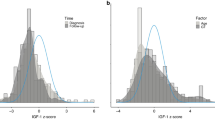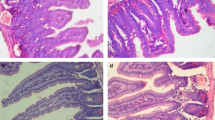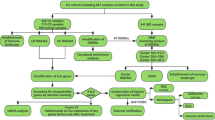Abstract
Spontaneous intestinal perforations in extremely premature infants are associated with glucocorticoid-induced thinning of the ileal bowel wall. We have previously demonstrated that insulin-like growth factor-1 (IGF-1) is abundant within the submucosa of the newborn mouse ileum but is diminished by glucocorticoid exposure, concomitant with bowel wall thinning. These findings prompted us to hypothesize that IGF-I governs submucosal growth during neonatal gut development and that diminished IGF-I abundance results in submucosal thinning. Heterozygous IGF-I knockout, wild type and homozygous IGF-I over-expresser newborn mice were euthanized at 3 d of life. Additionally, wild type newborn mice received daily dexamethasone (DEX) (1μg/gm/d) or vehicle control on days of life 1 and 2 and were also euthanized at 3 d of life. Their ileums were harvested, fixed and the resulting sections were processed in parallel for IGF-I immunohistochemistry and morphometric measurements of submucosal thickness and bowel diameter. Immunolocalization of IGF-I in each genotype was also compared with that seen in DEX-treated and control mice euthanized at the same time of life. IGF-I heterozygous knockouts had diminished submucosal IGF-I immunolocalization (similar to that seen in DEX-treated newborn mice) whereas homozygous IGF-I over-expressers exceeded that seen within wild type mice. IGF-I genotype and submucosal abundance was positively correlated with ileal submucosal thickness. DEX treatment of newborn mice diminished IGF-I and caused significant thinning of the submucosa compared with controls. Submucosal growth and thickness in the neonatal mouse ileum is governed by IGF-I and is diminished by dexamethasone treatment.
Similar content being viewed by others
Log in or create a free account to read this content
Gain free access to this article, as well as selected content from this journal and more on nature.com
or
Abbreviations
- DEX:
-
dexamethasone
- OE:
-
over-expressor
- KO:
-
knockout
- WT:
-
wild type
- IGF-1:
-
insulin-like growth factor-1
References
Gordon PV, Young ML, Marshall DD 2001 Focal small bowel perforation: an adverse effect of early postnatal dexamethasone therapy in extremely low birth weight infants. J Perinatol 21: 156–160
Gordon P, Rutledge J, Sawin R, Thomas S, Woodrum D 1999 Early postnatal dexamethasone increases the risk of focal small bowel perforation in extremely low birth weight infants. J Perinatol 19: 573–577
Garland JS, Alex CP, Pauly TH, Whitehead VL, Brand J, Winston JF, Samuels DP, McAuliffe TL 1999 A three-day course of dexamethasone therapy to prevent chronic lung disease in ventilated neonates: a randomized trial. Pediatrics 104: 91–99
Stark AR, Carlo WA, Tyson JE, Papile LA, Wright LL, Shankaran S, Donovan EF, Oh W, Bauer CR, Saha S, Poole WK, Stoll BJ 2001 Adverse effects of early dexamethasone in extremely-low-birth-weight infants. National Institute of Child Health and Human Development Neonatal Research Network. N Engl J Med 344: 95–101
Nanthakumar NN, Henning SJ 1995 Distinguishing normal and glucocorticoid-induced maturation of intestine using bromodeoxyuridine. Am J Physiol 268: G139–G145
Henning S, Rubin D, Shulman R 1994 Ontogeny of the intestinal mucosa. In: Johnson L, editor. Physiology of the gastrointestinal tract. Raven, New York, 571–610.
Burrin DG, Wester TJ, Davis TA, Fiorotto ML, Chang X 1999 Dexamethasone inhibits small intestinal growth via increased protein catabolism in neonatal pigs. Am J Physiol 276: E269–E277
Tatekawa Y, Muraji T, Imai Y, Nishijima E, Tsugawa C 1999 The mechanism of focal intestinal perforations in neonates with low birth weight. Pediatr Surg Int 15: 549–552
Gordon PV, Price WA, Stiles AD 2001 Dexamethasone administration to newborn mice alters mucosal and muscular morphology in the ileum and modulates IGF-I localization. Pediatr Res 49: 93–100
Liu JP, Baker J, Perkins AS, Robertson EJ, Efstratiadis A 1993 Mice carrying null mutations of the genes encoding insulin-like growth factor I (Igf-1) and type 1 IGF receptor (Igf1r). Cell 75: 59–72
Ohneda K, Ulshen MH, Fuller CR, D'Ercole AJ, Lund PK 1997 Enhanced growth of small bowel in transgenic mice expressing human insulin-like growth factor I. Gastroenterology 112: 444–454
D'Ercole AJ 1993 Expression of insulin-like growth factor-I in transgenic mice. Ann NY Acad Sci 692: 149–160
Pete G, Fuller CR, Oldham JM, Smith DR, D'Ercole AJ, Kahn CR, Lund PK 1999 Postnatal growth responses to insulin-like growth factor I in insulin receptor substrate-1-deficient mice. Endocrinology 140: 5478–5487
Laemmli UK 1970 Cleavage of structural proteins during the assembly of the head of bacteriophage T4. Nature 227: 680–685
Keller TC, Gordon PV 1991 Discrete subcellular localization of a cytoplasmic and a mitochondrial isozyme of creatine kinase in intestinal epithelial cells. Cell Motil Cytoskeleton 19: 169–179
Bloomfield FH, Knight DB, Breier BH, Harding JE 2001 Growth restriction in dexamethasone-treated preterm infants may be mediated by reduced IGF-I and IGFBP-3 plasma concentrations. Clin Endocrinol (Oxf) 54: 235–242
Kuemmerle JF 1997 Autocrine regulation of growth in cultured human intestinal muscle by growth factors. Gastroenterology 113: 817–824
Kuemmerle JF, Bushman TL 1998 IGF-I stimulates intestinal muscle cell growth by activating distinct PI 3-kinase and MAP kinase pathways. Am J Physiol 275: G151–G158
Gordon PV, Price WA, Stiles AD, Rutledge JC 2001 Early postnatal dexamethasone diminishes transforming growth factor alpha localization within the ileal muscularis propria of newborn mice and extremely low-birth-weight infants. Pediatr Dev Pathol 4: 532–537
Acknowledgements
The authors thank Sarabeth L. Thomas M.S., for proof reading and helpful discussions.
Author information
Authors and Affiliations
Corresponding author
Additional information
Support for this project was provided through grants from the NIH: CHRCDA HD01421 (P.V.G) and NIDDK 1KO8DK/HD61553-01 (P.V.G.).
Rights and permissions
About this article
Cite this article
Herman, A., Carlisle, E., Paxton, J. et al. Insulin-like Growth Factor-I Governs Submucosal Growth and Thickness in the Newborn Mouse Ileum. Pediatr Res 55, 507–513 (2004). https://doi.org/10.1203/01.PDR.0000110525.30786.50
Received:
Accepted:
Issue date:
DOI: https://doi.org/10.1203/01.PDR.0000110525.30786.50
This article is cited by
-
Risk factors and epidemiology of spontaneous intestinal perforation among infants born at 22–24 weeks’ gestational age
Journal of Perinatology (2024)
-
Spontaneous intestinal perforation (SIP) will soon become the most common form of surgical bowel disease in the extremely low birth weight (ELBW) infant
Journal of Perinatology (2022)
-
Ruminal epithelium transcriptome dynamics in response to plane of nutrition and age in young Holstein calves
Functional & Integrative Genomics (2014)
-
Basic and translational research in neonatal pharmacology
Journal of Perinatology (2006)
-
A pilot study of inhaled nitric oxide in preterm infants treated with nasal continuous positive airway pressure for respiratory distress syndrome
Intensive Care Medicine (2005)



